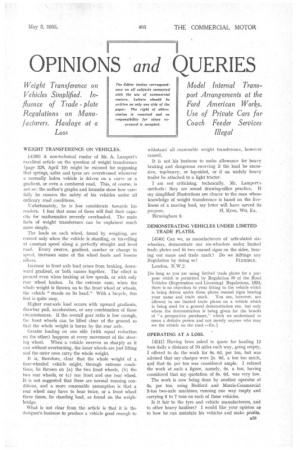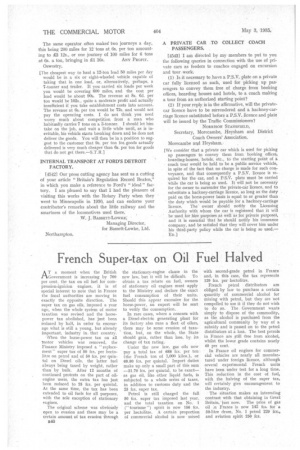OPINIONS and QUERIES
Page 53

Page 54

If you've noticed an error in this article please click here to report it so we can fix it.
WEIGHT TRANSFERENCE ON VEHICLES.
E4539] A non-technical reader of Mr. A. Lampert's excellent article on the question of weight transference (page 328, April 19) might be excused for supposing that springs, axles and tyres are overstressed whenever a normally laden vehicle is driven on a curve or a gradient, or even a cambered road. This, of course, is not so: the author's graphs and formulae show how carefully he ensures the safety of his vehicles under all ordinary road conditions.
Unfortunately, he is Jess considerate towards his readers. I fear that some of them will find their capacity for mathematics severely overloaded. The main facts of weight transference can be explained much more simply.
The loads on each wheel, found by weighing, are correct only when the vehicle is standing, or travelling at constant speed along a perfectly straight and level road. Every swerve, gradient, camber or change in speed, increases some of the wheel loads and lessens others.
increase in front axle load arises from braking, downward gradient, or both causes together. The effect is present even when braking at low speeds, or with only rear wheel brakes. In the extreme case, when the whole weight is thrown on to the front wheel or wheels, the vehicle " stands on its head." With a bicycle, this feat is quite easy.
Higher rear-axle load occurs with upward gradients, drawbar pull, acceleration, or any combination of these circumstances. If the overall gear ratio is low enough, the front wheels can be lifted clear of the ground so that the whole weight is borne by the rear axle.
Greater loading on one side (with equal reduction On the other) happens at every movement of the steering wheel. When a vehicle swerves as sharply as it can without overturning, the inner wheels are just lifting and the outer ones carry the whole weight.
It is, therefore, clear that the whole weight of a four-wheeled vehicle might, through extreme conditions, be thrown On (a) the two front wheels, (b) the two rear wheels, or (c) one front and one rear wheel. It is not suggested that these are normal running conditions, and a more reasonable assumption is that a rear wheel may have to bear twice, or a front wheel three times, its standing load, as found on the weighbridge. bridge.
What is not clear from the article is that it is the designer's business to produce a vehicle good enough to
withstand all reasonable weight transference, however caused.
It is not his business to make allowance for heavy braking and dangerous swerving if the load be excessive, top-heavy, or lop-sided, or if an unduly heavy trailer be attached to a light tractor.
I am not criticizing, technically, Mr. Lampert's methods: they are sound drawing-office practice. If my simplified illustrations are clearer to the man whose knowledge of weight transference is bathed on the liveliness of a moving load, my letter will have served its purpose. H. KING, Wm Ex. Birmingham 9.
DEMONSTRATING VEHICLES UNDER LIMITED TRADE PLATES.
[45401 Can we, as manufacturers of articulated sixwheelers, demonstrate our six-wheelers under limited trade plates and fit two enamel signs on the sides, bearing our name and trade mark? Do we infringe any
Regulation by doing so? FLEXIBLE. London, KW.2.
[So long as you are using limited trade plates for a purpose which is permitted by Regulation 30 of the .Road Vehicles (Registration and Licensing) Regulations, 1924, there is no objection to your fitting to the vehicle which is being driven under those plates enamel signs hearing your name and trade mark. You are, however, not allowed to use limited trade plates on a vehicle which is being used for a general demonstration run, but only where the demonstration is being given for the benefit of "a prospective purchaser," which we understand to mean a definite person and not merely anyone who may see the vehicle on the road.—En.i
OPERATING AT A LOSS.
P15411 Having been asked to quote for hauling 12 tons daily a distance of 50 miles each way, going empty, I offered to do the work for 8s. 6d. per ton, but was advised that my charges were 2s. 6d. a ton too much,• and that 6s. per ton was considered ample. I refused the work at such a figure, namely, 6s a ton, having considered that my quotation of 8s. 6d. was very low.
The work is now being done by another operator at es. per ton, using Bedford and Morris-Commercial 3-ton two-axle machines, running one way empty and carrying 6 to 7 tons on each of these vehicles.
Is it fair to the tyre and vehicle manufacturers, and to other heavy hauliers? I would like your opinion as to how he can maintain his vehicles and make profits. u39 The same operator often makes two journeys a day, this being 200 miles for 12 tons at 65. per ton amounting to £3 12s., or one journey of 100 miles for 6 tons at Os. a ton, bringing in £1 16s. ANY PROFIT. Oswestry.
[The cheapest way to haul a 12-ton load 50 miles per day would be in a six or eight-wheeled vehicle capable of taking that in one load, or, alternatively, perhaps, a 7-tonner and trailer. If you carried six loads per week you would be covering 600 miles, and the cost per load would be about 90s. The revenue at Ss. 6d. per ton would be 102s., quite a moderate profit and actually insufficient if you take establishment costs into account. The revenue at 6s. per ton would be 72s. and would not pay the operating costs. I do not think you need worry much about competition from a man who habitually carries 7 tons on a 3-tonner. I should let him take on the job, and wait a little while until, as is inevitable, his vehicle starts breaking down and he does not deliver the goods. You will then be in a position to suggest to the customer that 9s. per ton for_ goods actually delivered is very much cheaper than 6s. per ton for goods that do not get there.—S.T.R.1
INTERNAL TRANSPORT AT FORD'S DETROIT FACTORY.
[45421 Our press cutting agency has sent us a cutting of your article "Britain's Regulation Record Beaten," in which you make a reference to Ford's " ideal " factory. I am pleased to say that I had the pleasure of visiting this works with the Rotary Party when they went to Minneapolis in 1930, and can endorse your contributor's remarks about the little railway and the smartness of the locomotives used there.
W. J. BASSETT-LOWKE,
Managing Director, for Bassett-Lowke, Ltd.
A PRIVATE CAR .TO COLLECT COACH PASSENGERS.
[45431 I am directed by my members to put to you the following queries in connection with the use of private cars as feeders to coaches engaged on excursion and tour work.
(1) Is it necessary to have a P.S.V. plate on a private car fully licensed as such, used for picking up passengers to convey them free of charge from booking offices, boarding houses and hotels, to a coach making a tour from an authorized starting point?
(2) If your reply is in the affirmative, will the privatecar licence have to be surrendered and a hackney-carriage licence substituted before a P.S.V. licence and plate will be issued by the Traffic Commissioners?
NORRISON STANSFIELID, Secretary, Morecambe, Heysham and District Coach Owners' Association.
Morecambe and Heysham.
1We consider that a private car which is used for picking up passengers to convey them from booking office, boarding-houses, hotels, etc., to the starting point of a coach tour would be held to be a public service vehicle, in spite of the fact that no charge is made for such conveyance, and that consequently a P.S.V. licence is required for the car, and a P.S.V. plate must be carried while the car is being so used. It will not be necessary for the owner to surrender the private-car licence, and to substitute a hackney-carriage licence, so long as the duty paid on the horse-power basis is equal to or greater than the duty which would be payable for a hackney-carriage licence. The owner should notify the Licensing Authority with whom the car is registered that it will be used for hire purposes as well as for private purposei, and it is essential that he should notify his insurance company, and be satisfied that they will cover him under his third-party policy while the car is being so used.— ED .




























































































